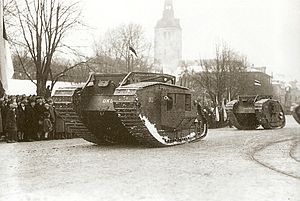- Mark V Composite tank in Estonian service
-
Mark V Composite 
Estonian Mark V Composite tanks on the Republic's anniversary parade on 24th of February, 1925.Type Heavy tank Place of origin  United Kingdom
United KingdomService history In service 4
1919–1940Used by  Estonia
EstoniaWars Estonian War of Independence Production history Manufacturer William Foster & Co. of Lincoln Produced 1918–1919 Specifications Weight 33 tonnes Length 8.25 m Width 3.65 m Height 2.65 m Crew 9 Armour 6–12 mm Main
armament1x57mm gun
200 rounds
3x7.7mm Hotchkiss Machine Guns
10350 roundsEngine Ricardo petrol engine
150 bhpSpeed 8 km/h The British Mark V Composite tank, a development of the Tank Mark I saw service with the Estonian Army in the Estonian War of Independence from 1919 to 1920.
Contents
Design and development
The Mark V was intended to be built as completely new design. When, however in December 1917, the desired new engine and transmission became available, this design was abandoned and the designation switched to an improved version of the Mark IV, in fact a Mark IV as it was originally intended: more power (150 bhp) with a new Ricardo engine, improved steering mechanism and epicyclical transmission, only one driver was needed. Cabin for machine-gunner on the roof. Four hundred were built, 200 each of Males and Females. Several were converted to Hermaphrodites by swapping sponsons to give a single 6 pounder gun and extra machine gun.
History
The first Mark V Composite tanks reached Estonia at the end of 1919.[1] Although Estonia previously requested tanks from the Entente, their request was originally refused. As the Allies feared Estonia might be defeated by the Soviets .[citation needed] An unexpected opportunity to obtain such tanks came when the Northwestern Army under Yudenich was overpowered by the Soviets and retreated towards Estonia. During the disolution of the Northwestern Army the Commander of the Estonian Defence Forces Johan Laidoner received permission to take custody of the Northwestern Army's tanks. This action brought four Mark V and two Renault FT 17 tanks to Estonia. According to the Commander-in-Chief's daily order nr.770 on the 26 November 1919 Captain Hans Vanaveski was ordered to organize a training unit under the name of Tank Class. This unit was placed under the direct orders of the Reserve Forces commander. This act was previously approved on 23 November by the Minister of War.
Heavy Tanks Company
Auto-Tanks Division
The end of the division
During the Soviet occupation
The heavy tank company was taken over by the Red Army in February 1941. The tanks were in a very poor condition and hardly able to move by their own power. As the Red Army did not have tank transport platforms for the railway, the tanks were left behind in a warehouse near Tallinn, which was soon after forgotten. The tanks were relocated again in August the same year when they were used to cover the Soviet retreat from Tallinn. Mark Vs were dug into the soil along the Pirita River coastal line in order to create stationary gun platforms for the defence line. There are no records however of the usage or success of this plan, yet it is certain that it was tried out.[2]
Appearance in World War II
The ultimate fate of these four Estonian Mark V Composite tanks is believed to have been melted down somewhere in the Third Reich into armour steel for the German total war effort. Would the outcome of history have been different these tanks had provided unique exhibits for the Estonian War Museum.[3]
Gallery
See also
Estonian Army in 1922
References
- ^ Estonian Armoured Machines. Tiit Noormets & Mati Õun. Tammiskilp 1999. Page 40
- ^ Estonian Armoured Machines. Tiit Noormets & Mati Õun. Tammiskilp 1999. Page 94
- ^ http://www.raamatukoi.ee/cgi-bin/raamat?79813
Estonian Armoured Machines. Tiit Noormets & Mati Õun. Tammiskilp 1999. Page 95
External links
Kaitsevägi  Estonian Defence Forces
Estonian Defence Forces Maavägi (Army)Baltic Battalion • Guard Battalion • Kuperjanov Battalion • HQ and Signals Battalion • Viru Battalion • Engineer Battalion • Artillery Battalion • Air Defence Battalion • Logistics BattalionKalev Battalion • Scouts Battalion • CSS Battalion • 11th Infantry Battlion • 12th Infantry Battlion • 13th Infantry Battalion
Maavägi (Army)Baltic Battalion • Guard Battalion • Kuperjanov Battalion • HQ and Signals Battalion • Viru Battalion • Engineer Battalion • Artillery Battalion • Air Defence Battalion • Logistics BattalionKalev Battalion • Scouts Battalion • CSS Battalion • 11th Infantry Battlion • 12th Infantry Battlion • 13th Infantry Battalion
1st Artillery Battalion • 1st Engineering BattalionJägala Garrison • Tapa Garrison • Tallinn Garrison • Jõhvi Garrison• Marja Garrison • Männiku Garrison • Narva-Jõesuu Garrison • Paldiski Garrison • Võru Garrison1st Territorial Battalion • 2nd Territorial Battalion • 3rd Territorial Battalion • 4th Territorial Battalion • 5th Territorial Battalion • 6th Territorial Battalion Merevägi (Naval Force)EML Admiral Cowan (M313) • EML Sakala (M314) • EML Ugandi (M315)EML Ristna (P422) • EML Suurop (P423) • EML Ahti (A431) • EML Tasuja (A432)
Merevägi (Naval Force)EML Admiral Cowan (M313) • EML Sakala (M314) • EML Ugandi (M315)EML Ristna (P422) • EML Suurop (P423) • EML Ahti (A431) • EML Tasuja (A432) Õhuvägi (Air Force)Air Surveillance DivisionAir Defence Battalion (Ground forces)Ämari Air Base • (Tallinn Air Base)Air Force Staff (Tallinn)
Õhuvägi (Air Force)Air Surveillance DivisionAir Defence Battalion (Ground forces)Ämari Air Base • (Tallinn Air Base)Air Force Staff (Tallinn) Kaitseliit (Defence League)Alutaguse malevHarju malevJärva malevJõgeva malevLääne malevPärnu malevPõlva malevTallinn malevTartu malevVõru malevValga malevViru malevKüberkaitseliit
Kaitseliit (Defence League)Alutaguse malevHarju malevJärva malevJõgeva malevLääne malevPärnu malevPõlva malevTallinn malevTartu malevVõru malevValga malevViru malevKüberkaitseliitTanks of Estonia Tankette 
Light tank Heavy tank Mark V CompositeCategories:- Military equipment of Estonia
Wikimedia Foundation. 2010.








